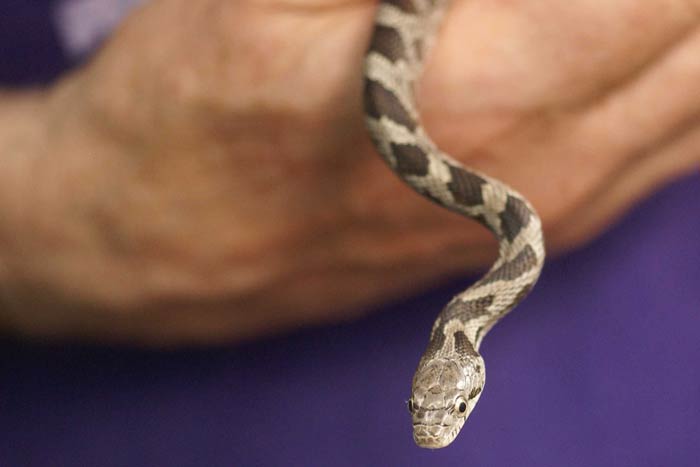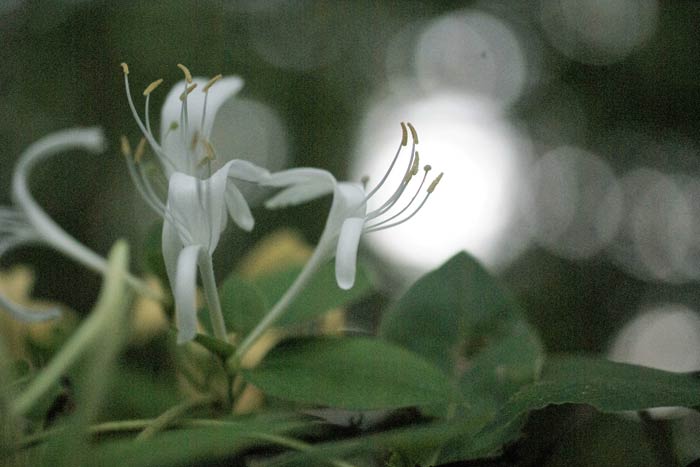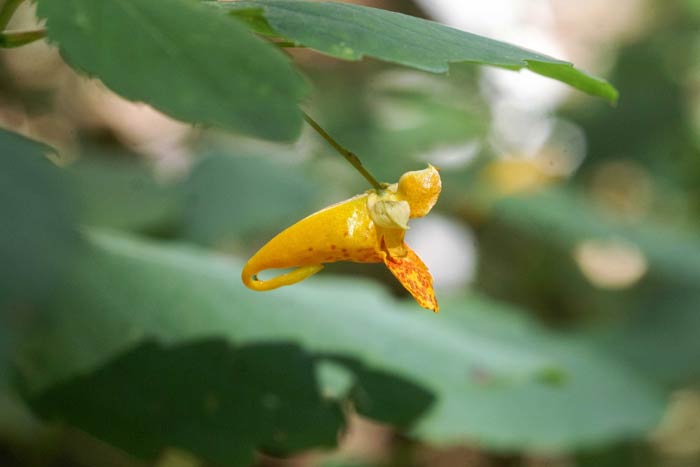
Young black rat snake in Spider’s hands. (photos by Anita Barbour)
We’ve always had dogs, and the two we have now — one for about seven years and the other for most of her 14 years — are fairly compatible companions, though they have those hackle-heavy moments from time to time. Because they tend to wander, they spend most of their outdoor time in a gated pen that came with the house, the former owners having raised Shetland sheepdogs. Ours are mutts, the smaller one a flat-coated retriever and the big one a golden retriever — chocolate Labrador retriever cross, according to their former owners.
The old Sheltie pen is a curious place, a sort of wetland almost, partly due to its underlying greywacke bedrock (a low-permeability, fine-grained sandstone) and partly due to compaction of thin soil by gravel laid down by a builder friend. The pen’s vegetation is a hodge-podge of mostly non-native herbs (“weeds”), a few surprising native herbs, and the invasive non-native woody vine, Japanese honeysuckle (Lonicera japonica). Among the notable native wetland herbs is green-fruited clearweed (Pilea fontana), once listed as rare in New York state, but which turns out actually to be fairly common. I think this shows that if enough people with good botanical eyes keep looking, assumed rarities sometimes prove not to be so rare after all.

One of our dogs, Max.

Common plantain.
One of the most abundant and robust plants in the dog pen is common plantain (Plantago major), in some places nicknamed “pig ears.” We find it elegant. Though introduced plant species such as common plantain are considered by gardening purists to be troublesome weeds, one non-native plant growing in the dog pen is undeniably benign and beautiful. The Asiatic dayflower (Commelina communis), with its mouse-eared, early-blooming blue-and-white blossoms is worthy of any spring garden. So is the native orange-flowered jewelweed or spotted touch-me-not (Impatiens capensis), so named for its spring-loaded fruits that explode and scatter seeds several feet from the parent plant. In shallow wetlands this species, with its stiff but hollow stems, often grows in dense stands. A bonus is that it also attracts hummingbirds.
In April of this year, the season started with the sounds of amphibians — spring peepers (Pseudacris crucifer) and American toads (Bufo americanus) in the wetlands across the road, plus gray tree frogs (Hyla versicolor) there and also around the edge of our little side pond and up in nearby trees. In May came snakes in the dog pen, the earliest an eastern garter snake (Thamnophis sirtalis) basking on the ground, then later a young black rat snake (Elaphe obsoleta obsoleta) emerging from a hole in the wood above the house’s concrete foundation where the snake apparently had spent the winter.

Japanese honeysuckle on the dog pen fence.
Perhaps the biggest surprise we found in the dog pen this year was not a plant, but an insect feeding on a plant, a sawfly larva eating the leaves of the Japanese honeysuckle. Sawflies are large flies that often mimic wasps in appearance and behavior (good protection from predators), but their larvae resemble caterpillars, and so gain protection by blending into the vegetation on which they feed. The two feeding on the honeysuckle didn’t fool us, but we were only interested in their taxonomic identity, down to species if possible.

Asiatic dayflower.
Looking on line helped, though there was more opinion than fact among the comments on the photos. We did find photos that matched ours. It turns out there are two very similar sawflies (family Cimbicidae in the insect order Diptera [true flies] whose larvae eat leaves of Japanese honeysuckle. These species are the native Abia americana, found across the United States, and the introduced A. lonicerae, said to be found only in the eastern states. Ours looked more like the native species.
Absent from the dog pen, but scattered in fairly dense patches in the rest of the yard, is motherwort (Leonurus cardiaca), a bristly alien plant of the mint family (Lamiatae). Motherwort is not “minty” in scent or flavor, but it is handsome — a lanky, stately plant, a sort of Lincoln among weeds. Its leaves are straightly paired, and arranged oppositely along the stiff stem, square in cross-section as is the rule in this prolific family that includes both wild and cultivated herbs. There’s a little stand just outside the dog pen gate, but that’s as close as it gets, who knows why.
Well, maybe the dogs do, but they aren’t saying.

One of the flower clusters of motherwort.

Jewelweed, or spotted touch-me-not.

Sawfly larva eating Japanese honeysuckle.

Spider and Anita… I am a huge fan of the Chrysalis ‘Definition’ record. I am a musician, originally from the UK, and now live in the USA. And funnily enough, I am working for an environmental charity so I am learning lots about the natural world, and have a burgeoning interest in insects and plants. Thank you both so much for all the work that you do.
I have a question for Spider… I love the song Lake Hope, and would like to visit the real Lake Hope one day. Can you tell me which Lake Hope you are singing about? I would love to know!
Many thanks and all the very best,
RJ